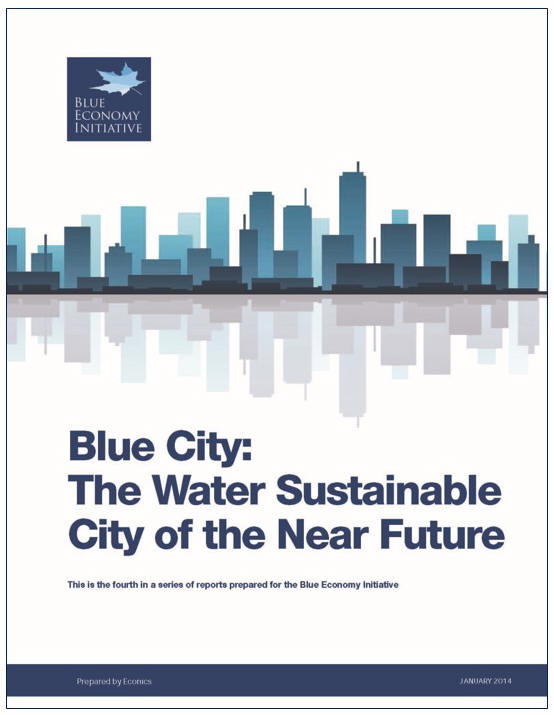BLUE CITY: “We set out to write a report that will help practitioners and decision makers build a business case for more sustainable, integrated water management,” stated Louise Brennan, report co-author (January 2014)
Note to Reader:
Canada faces an estimated cost of $88 billion water and wastewater infrastructure deficit and this estimate is expected to grow under a “business as usual” approach. As record infrastructure costs grow, the need for innovative solutions alongside innovative funding mechanisms, are increasingly in demand.
In January 2014, and to facilitate change, the Blue Economy Initiative released a visionary report, Blue City: The Water-Sustainable City of the Near Future, authored by Econics.
The Blue Economy Initiative (BEI) is a national project founded by Canadian Water Network, the Royal Bank of Canada, and the Walter and Duncan Gordon Foundation. Their shared long-term vision is for Canada to have a prosperous future as a global leader in water sustainability. They advocate for a national and global “blue economy” that recognizes all economic development should be pursued within a water sustainability framework.

Pitching Change: Making the Business Case
“ We wanted Blue City to be an accessible report, grounded in rigorous research and analysis but presented in the style of a magazine. We did not want to create a ‘how-to’ guide. Instead, this is intended to stimulate a discussion about the complexities of urban water management. More importantly, though, we offer a vision of what is possible in the near future,” explains Kirk Stinchcombe, Econics founder and lead author.
We wanted Blue City to be an accessible report, grounded in rigorous research and analysis but presented in the style of a magazine. We did not want to create a ‘how-to’ guide. Instead, this is intended to stimulate a discussion about the complexities of urban water management. More importantly, though, we offer a vision of what is possible in the near future,” explains Kirk Stinchcombe, Econics founder and lead author.
 “We set out to write a report that will help practitioners and decision makers build a business case for more sustainable, integrated water management. The city we describe, although fictitious, is largely an amalgamation of real cities. These innovations are actually occurring in places across the country and around the world. This place is within reach of Canadian municipalities now,” continues Louise Brennan, Sustainability Specialist and report co-author.
“We set out to write a report that will help practitioners and decision makers build a business case for more sustainable, integrated water management. The city we describe, although fictitious, is largely an amalgamation of real cities. These innovations are actually occurring in places across the country and around the world. This place is within reach of Canadian municipalities now,” continues Louise Brennan, Sustainability Specialist and report co-author.
“To create this report, we interviewed people from all over Canada – experts that spend a lot of time thinking about water, from all kinds of different perspectives – a lawyer, a landscape architect, a financier, the director of a major water utility, an engineering professor, a consultant, and many more. We were particularly happy to include the Partnership for Water Sustainability in British Columbia’s own Kim Stephens in this diverse group.”
“Kim brought important British Columbian and NGO perspectives to our analysis. Among his insights, he reminded us that change does not have to be revolutionary – that a lot of the time it is doing the smaller, common sense practices that add up to create the big picture,” concludes Kirk Stinchcombe.
“The magazine style of Blue City is great,” observes Kim Stephens. “This approach is bound to inspire dialogue among Canadian decision-makers and key influencers around the opportunities and benefits of preserving water, and the economic risks of not making sustainable decisions.“


